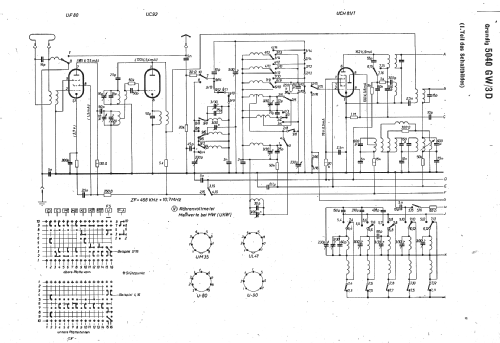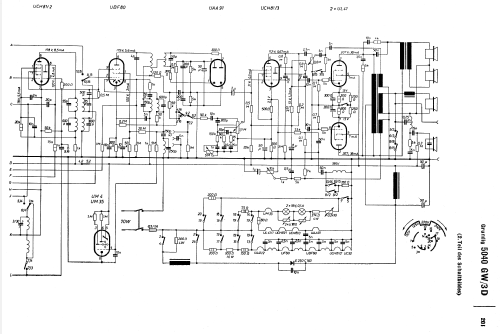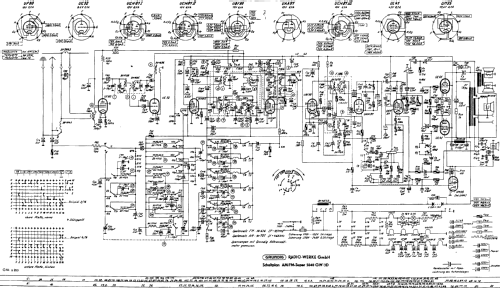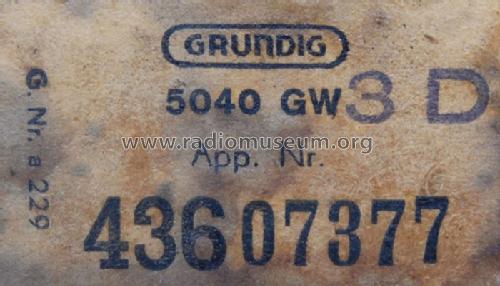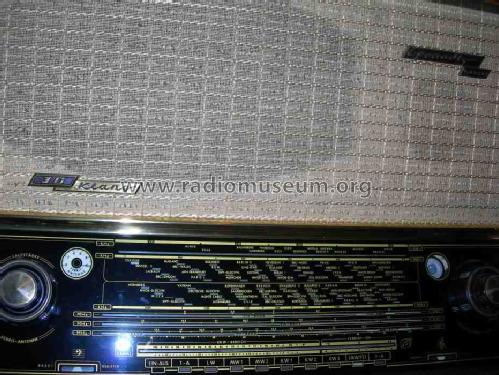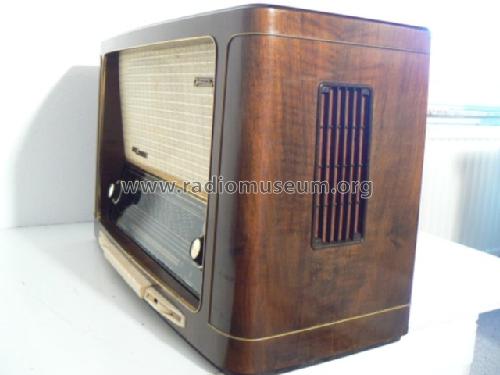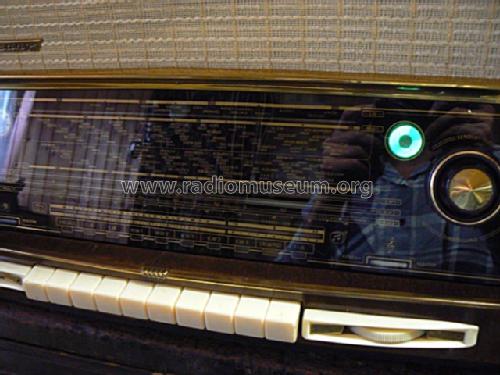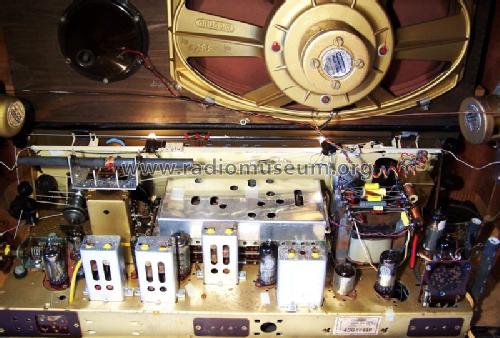Konzertgerät 5040GW/3D
Grundig (Radio-Vertrieb, RVF, Radiowerke); Fürth/Bayern
- Hersteller / Marke
- Grundig (Radio-Vertrieb, RVF, Radiowerke); Fürth/Bayern
- Jahr
- 1954/1955
- Kategorie
- Rundfunkempfänger (Radio - oder Tuner nach WW2)
- Radiomuseum.org ID
- 2041
-
- anderer Name: Grundig Portugal || Grundig USA / Lextronix
Klicken Sie auf den Schaltplanausschnitt, um diesen kostenlos als Dokument anzufordern.
- Anzahl Röhren
- 10
- Hauptprinzip
- Super mit HF-Vorstufe; ZF/IF 468/10700 kHz; 3 NF-Stufe(n)
- Anzahl Kreise
- 11 Kreis(e) AM 11 Kreis(e) FM
- Wellenbereiche
- Langwelle, Mittelwelle, mehrere Kurzwellenbänder plus UKW (FM).
- Betriebsart / Volt
- Allstromgerät / 110; 125; 220; 240 Volt
- Lautsprecher
- 4 Lautsprecher
- Belastbarkeit / Leistung
- 8 W (Qualität unbekannt)
- Material
- Gerät mit Holzgehäuse
- von Radiomuseum.org
- Modell: Konzertgerät 5040GW/3D - Grundig Radio-Vertrieb, RVF,
- Form
- Tischgerät, Tasten oder Druckknöpfe.
- Abmessungen (BHT)
- 706 x 444 x 318 mm / 27.8 x 17.5 x 12.5 inch
- Bemerkung
- Grundig Konzertgerät 5040GW/3D hat im Gegensatz zum Wechselstrom-Modell 5040W/3D keine Motorabstimmung. Additive Triodenmischung für die AM-Bereiche. Der VDRG-Katalog 1954/55 führt irrtümlich UF89 als UKW-Vorstufe, lediglich 1x UL41 als Endstufe.
- Nettogewicht
- 17.3 kg / 38 lb 1.7 oz (38.106 lb)
- Originalpreis
- 565.00 DM
- Datenherkunft
- HdB d.Rdf-& Ferns-GrH 1954/55 / Radiokatalog Band 1, Ernst Erb
- Literatur/Schema (1)
- -- Schematic
- Weitere Modelle
-
Hier finden Sie 6213 Modelle, davon 5446 mit Bildern und 4211 mit Schaltbildern.
Alle gelisteten Radios usw. von Grundig (Radio-Vertrieb, RVF, Radiowerke); Fürth/Bayern
Sammlungen
Das Modell Konzertgerät befindet sich in den Sammlungen folgender Mitglieder.
Forumsbeiträge zum Modell: Grundig Radio-: Konzertgerät 5040GW/3D
Threads: 2 | Posts: 2
I am restoring a Grundig 5040W/3D and want to share photographs and what I have learned. I have uploaded some photographs from the initial steps of restoration. I used schematics and forum information from radiomuseum.org, thank you!
Here is what I have done so far:
Replaced almost ALL capacitors - most of the paper capacitors were bad, leaky or out of tolerance. They have been replaced with modern capacitors, some of them were replaced with "Orange Drop" capacitors (see photos). Special consideration given to any coupling capacitors such as the one that drives the grid of the EL-12 tube. A shorted or leaky capacitor here will place positive voltage on the grid causing the tube to conduct heavily and over heat. Evidence is seen in the cathode resistor of the EL-12 which may be burned or actually smoke!
Replaced selenium rectifier with modern silicon rectifiers - the original rectifier in the black can (probably selenium) had too much resistance and over heated, so the high voltages to the tubes was too low. Replaced with four 1KV 1A silicon diodes (see photo). The set really came alive after that! I left the old rectifier on the chassis and simply clipped its leads to preserve as much of the original look as possible.
Replaced some weak tubes. I used a tube tester to identify bad tubes and replaced them. All except the EL-12 and EF804 have American equivalents.
The full resolution (large) photos of the project are available on Photobucket at this LINK.
I will try to post more information as the project continues.
James Miller
James Miller, 16.Dec.11
http://www.radiomuseum.org/forum/additive_mischschaltungen_in_den_am_wellenbereichen.html
finden Sie ausführliche Informationen zum Thema Additive Mischung in den AM-Bereichen.
Andreas Steinmetz, 09.Jun.05
